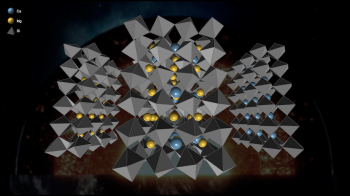[ad_1]
October 19, 2022
What is the structure of the Earth? To begin with, it consists of several layers: the crust, the upper and lower mantle, and the core.
The mantle makes up most of the volume of our planet: 84%. The lower mantle represents 55% of the Earth’s volume; it is also hotter and denser than the upper mantle.

Atomic-scale crystal structures of mantle perovskites. From left to right: Bridgmanite (magnesium-rich), new mantle perovskite with magnesium and calcium, Davemaoite (calcium-rich). Credit: Crystal structure images courtesy of Dan Shim; background image courtesy iStock/Getty Images.
Download the full image
The lower mantle has played an important role in Earth’s evolution, including how Earth has cooled over billions of years, how materials have circulated, and how water is stored and transported from from and into the deep interior on a geologic time scale.
For more than seven decades, the mineralogy of the lower mantle has been extensively studied. Decades of study, including laboratory experiments, computational simulations, and the study of inclusions in deep diamonds, led to the conclusion that the lower mantle consists of three main minerals: bridgmanite, ferropericlase, and davemaoite.
In a study recently published in Nature, a team of scientists, including Byeongkwan Ko, a former PhD student at Arizona State University and now a postdoctoral researcher at Michigan State University, and Dan (Sang-Heon) Shim, a professor of the School of the Earth and the ASU. Space Exploration and a Navrotsky Professor of Materials Research at ASU, have completed a new high-pressure experiment that employs different styles of heating to reveal an additional mineral that resides in the lower mantle.
Among these three main minerals, two minerals—bridgmanite and davemaoite—have the so-called perovskite-type crystal structures. This structure is also widely known in physics, chemistry and materials engineering, as some materials with a perovskite-type structure have shown superconductivity.
At shallow depth, minerals with similar crystal structures often fuse and become single minerals, usually in a high-temperature environment. For example, the mineral diopside has calcium and magnesium, and is stable in the crust. Despite the structural similarity, however, existing studies have shown that calcium-rich davemaoite and magnesium-rich bridgmanite remain separate throughout the lower mantle.
“Why don’t davemaoite and bridgmanite fuse into one despite having very similar atomic-scale structures? This question has fascinated researchers for two decades,” Shim said. “Many attempts have been made to find conditions where these two minerals merge, but the answer from experiments has consistently been two separate minerals. Here we felt we needed some new ideas in experiments.”
The new experiment was an opportunity for the research group to test various heating techniques to compare methods. Instead of raising the temperature slowly in conventional high-pressure experiments, they raised the temperature very quickly to the high temperature associated with the lower mantle, reaching 3,000 to 3,500 degrees. Fahrenheit in a second The reason for this was that once two perovskite-structured minerals are formed, it is very difficult for them to fuse, even if they enter temperature conditions where a single perovskite mineral should be stable.
By rapidly heating the samples to target temperatures, Ko and Shim were able to prevent the formation of two perovskite-structured minerals at low temperatures. Once they reach the temperature of the lower mantle, they monitor which minerals form for 15 to 30 minutes using X-ray beams at the Advanced Photon Source. They found that only one perovskite mineral is formed, unexpected from previous experiments. They found that at sufficiently high temperatures, above 3,500 F, davemaoite and bridgmanite become a single mineral in the perovskite-type structure.
“It has been thought that a large size difference between calcium and magnesium, the main cations of davemaoite and bridgmanite, respectively, should prevent the fusion of these two minerals,” Ko said. “But our study shows that they can overcome this difference in warm environments.”
Experiments suggest that the deeper lower mantle with a sufficiently high temperature should have a different mineralogy than the shallower lower mantle. Because the mantle was much warmer on the early Earth, the group’s new results indicate that most of the lower mantle then had a single perovskite-structured mineral, meaning the mineralogy was different from today’s lower mantle.
This new observation has a number of substantial impacts on our understanding of the deep Earth. Many seismic observations have shown that the properties of the deeper lower mantle are different from those of the shallower lower mantle. The changes are reported to be gradual. The fusion of bridgmanite and davemaoite is shown to be gradual in the research group’s experiments. Also, the properties of a rock with three main minerals—bridgmanite, ferropericlase, and davemaoite—do not match well with the properties of the deeper lower mantle. Ko and his collaborators predict that these unresolved issues can be explained by a fusion of bridgmanite and davemaoite into a unique new perovskite-structured mineral.
Other authors who have collaborated in this study are Eran Greenberg, of the University of Chicago; Vitali Prakapenka, University of Chicago; E. Ercan Alp, Argonne National Laboratory; Wenli Bi, University of Alabama at Birmingham; Yue Meng, Argonne National Laboratory; Dongzhou Zhang, University of Chicago and University of Hawai’i at Mano.
[ad_2]Source: ASU psychology student aims to change the conversation about addiction
Methadone Clinics Near Me – Methadone Clinic NYC – Methadone Clinics USA















